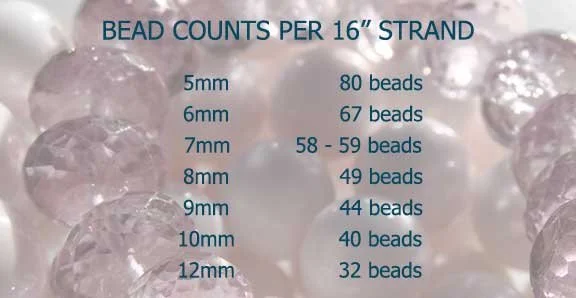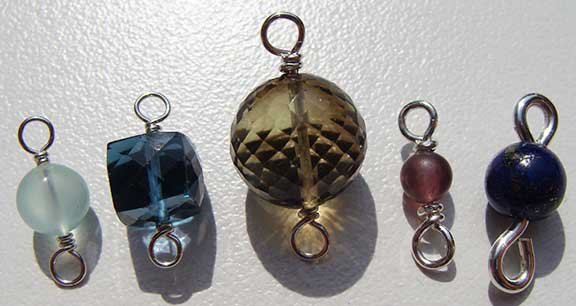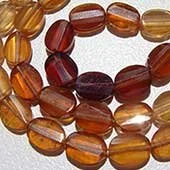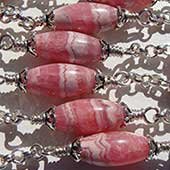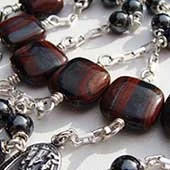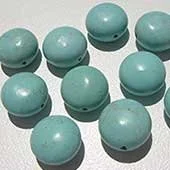Materials and Sizing: Beads
The most sensible place to start when designing a chained rosary is with the beads. Not just for the aesthetics of color, but because their sizes, shapes and drill holes will determine your wire gauge, construction method, the link size of your chain, the fit of your embellishments, and, to a lesser extent, your choice of crucifix and center.
Beads are available in an enormous variety of materials: wood, glass, metal, precious and semi-precious stones, ceramic, bone, horn, shell... the list is practically endless! Let's look at how to purchase beads for a full, five decade rosary.
A five decade rosary requires a total of 59 beads: 53 for the Hail Marys and 6 for the Our Fathers.
Beads are most often sold by the strand. The standard length of a strand is 16 inches. The chart on the left describes how many round beads you should receive on a full strand by bead size.
You can see that a single strand of 6mm or 7mm round beads will provide sufficient beads for all 53 Hail Marys. For an 8mm rosary, you will need a strand and a half to two full strands of beads to have enough quantity for the 53 Hail Marys. Differing Our Fathers will be extra.
It's very important that you know the count of beads on a strand before you purchase. When shopping online, always count the beads in the supplier photo or ask the supplier for a count. Count the beads in hand if you're shopping locally rather than online. You should bear in mind two critical points about bead strands when you shop: the industry standard is that a variance of .5mm in bead size is acceptable on a strand before it's called "graduated." So if you don't count, you could wind up with a strand of mostly 5.5mm beads rather than 6mm, which can be highly annoying when they're advertised as 6mm.
The second point to bear in mind is the actual strand length you'll be receiving. Many beads are sold on shorter 8 inch, 10 inch, 14 inch, etc. strands which will reduce the strand count of beads. Read the listings carefully!
Counts per strand for rondelle beads will be higher, as the diameter is greater than the thickness, so more beads will fit on a strand. Counting the rondelle beads will help you pin down the average thickness of the beads, which is critical for the handling of your completed rosary. More information on working with rondelle beads is provided below.
Bead Drills
Most man-made beads, such as glass and metal, have very consistent drill holes and are easier to work with when you're giving your first few rosaries a try. The world of natural material beads, like semi-precious stone, pearls and wood are a different story!
In the photo to the right, I've wired a 6mm chalcedony, an 8mm blue topaz, a 13mm smoky quartz, a 5mm tourmaline and a 6mm lapis bead with the thickest wire their drills will accept. The 6mm lapis takes a 16g wire, while 22g is a very tight fit with the huge smokey quartz. This is to illustrate the point that drill size does NOT always correlate to bead size. This is why you buy the beads first!
A good bet on reliably-sized drills, if you'd like to start with semi-precious gemstone beads, are the more common stones. Most jaspers, carnelian, agates, rose quartz, black onyx, amethyst and garnet (not gemmy), will take 20g wire whether the bead is 6mm, 8mm or 10mm.
In very general terms, freshwater pearl and mother of pearl beads often have very small drills, 22g if you're lucky, to as tiny as 24g or 26g. On the opposite end of the spectrum, wood and bone beads usually have very large drills, upwards of 1.5mm. So for your first rosaries, you might want to keep away from these extremes, as they do introduce some technical challenges to your construction.
You will also need a couple of short wire spools with which to test your bead drills and practice your first loops and wraps. One 20g and one 22g are the most useful. Meinssen Rosary Metals offers raw (unfumed) red brass wire practice coils, which are a half hard temper and good for getting a feel for the stiffness of wire which works best for durable rosaries.
Proportions
Using shaped beads in your rosaries will greatly expand your creativity and rosary-making enjoyment! Here are a few tips on getting the sizing proportions right for shaped beads, so that your finished rosary not only looks great, but functions properly, too.
In the photo to the right, you see two strands of rondelle-shaped beads, ruby and phosphosiderite. Both are 8mm diameter. But notice that the phosphosiderite beads are very skinny, from 2mm thick to a few beads about 4.5mm thick.
Now imagine those skinny beads worked up in a rosary. Not very pleasant for the fingers, which can easily "fall off" such a bead, or the bead can have a sharp feel. Best advice is to give the skinnies a pass.
When buying rondelles, look for fat beads, like the rubies shown here. 7mm x 5mm, 8mm x 6mm, 10mm x 8mm are ideal proportions. What's great about chubby rondelles is that you will achieve a finished rosary that's more compact than full round without losing the ease in handling the beads!
In the photos below, you'll see just some of the great variety of shapes that work nicely as Our Father beads.
To size shaped beads with round bead Hail Marys, a good rule of thumb is to purchase flat beads (flat coin, flat square) which are about double the diameter of the Hail Marys. For example, 12mm flat square Our Fathers with 6mm round Hail Marys. With flat oval, flat oblong and puffy (thicker) beads, you can get away with less than double in one dimension, such as 8mm round beads with 13mm x 18mm flat ovals, or 10mm puffy coins with 6mm rounds.
For long rice, teardrops and barrels, try to find beads that have a diameter at least as large as your Hail Marys, and don't be afraid to go long on the length. For example, 8mm round Hail Marys with 8mm x 16mm long rice.
These are all just suggestions to protect your wallet from purchasing errors when you're just getting started. As your bead stock grows and you find a shaped bead that you simply can't resist, go for it! It may inspire your very best rosary design. Half the fun of learning all the rules is learning how to break them, so have fun with your beads!
Bead Purchasing Tips
1. Strand length: When purchasing beads, pay close attention to the length of the strand! Some beads, especially the more costly gemstones, are strung on 8", 10" and 14" thread lengths. Always count the beads shown in a supplier photograph, ask the supplier directly, or count in hand (when shopping locally) before you begin construction so that you don't come up short.
2. Try bracelet lengths for 8mm beads: half strands and bracelet lengths of beads can be a boon to your budget and to the quality you might offer your customers. Three bracelet lengths of 8mm should give you enough for all 53 Ave beads and save the cost of half a strand! You might pocket the savings, or use it for a quality upgrade on embellishments or chain. A bracelet length of 8mm should fall around 20 beads. Be sure to count.
3. Scale in design: Should you choose to use one size of bead for the Hail Marys and a larger size for the Our Fathers, the relative sizes between the beads are important in your design. If you are new to rosary making and don't have a good feel yet for bead diameters and the finished length of your rosary, keep the scale tight, to 2mm difference in the diameters between Aves and Paters for round beads.
4. Should you choose to use a larger, alternate color, or differently shaped bead for the Our Fathers, remember that that requires an extra strand; an added expense you'll have to include in your budget. If money is tight, it's fine to use one size of bead for all 59, and cap the Our Fathers.
5. Always buy your beads first, check the drills for the gauge of wire you'll need for them, then purchase your caps and chain to suit.

